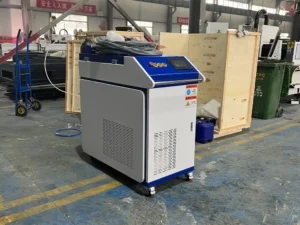Introduction:
Laser cleaning machines have revolutionized industrial cleaning processes. They offer a precise and efficient way to remove contaminants from various surfaces. Like any technology, these machines have challenges. This article will explore common problems encountered with laser cleaning machines. We will also provide practical solutions to address them.
Common Problems And Solutions For Laser Cleaning Machines

1. Lack of Cleaning Efficiency
One of the primary issues is insufficient cleaning efficiency. This problem can arise from various factors. Examples are inadequate laser power, incorrect focal length, or improper beam delivery.
Solution:
It’s crucial to ensure that the laser power is good. This applies to the specific application. Adjusting the focal length is essential. Optimizing beam delivery can also impact cleaning effectiveness. Regular maintenance is vital. This includes cleaning the optics. Checking for any damage is necessary to guarantee optimal performance.
2. Incomplete Contaminant Removal
Laser cleaning machines may leave contaminants, especially when dealing with stubborn materials. The reason may be insufficient power or incorrect laser parameters.
Solution:
To address incomplete contaminant removal, users should assess the nature of the contaminants. Once done, adjust the laser parameters. Increasing the laser power and altering the pulse duration are essential. Modifying the scanning speed can help achieve better results. Additionally, experimenting with different laser wavelengths may prove effective for specific materials.
3. Safety Concerns
Safety is paramount when working with laser cleaning machines. Issues can arise if proper precautions are not taken. Laser beams can harm the eyes and skin, and there is a risk of fire when dealing with certain materials.

Solution:
Implementing strict safety measures is imperative. Users should always wear appropriate protective gear, including laser safety glasses. Establishing clear safety protocols and providing training to operators can limit the risks. These are often associated with laser cleaning machines. Additionally, working in a well-ventilated area is crucial. Also, having firefighting equipment on hand can mitigate the risk of fire.
4. Thermal Damage to Substrates
Excessive heat is generated during the laser cleaning. This can lead to thermal damage, especially to the substrate materials. They are particularly for sensitive surfaces or materials with low heat resistance.
Solution:
To prevent thermal damage, users should select the appropriate laser parameters. This is for the specific substrate. This may involve adjusting the laser power and pulse duration. Also, scanning speed to find the optimal combination is essential. Using a laser with variable power settings is good. It allows for greater control and minimizes the risk of thermal damage.
5. Maintenance and Downtime
Laser cleaning machines use regular maintenance like any machinery to ensure consistent performance. Unexpected breakdowns can result in costly downtime for industrial processes.
Solution:
Establishing a routine maintenance schedule is crucial for preventing unexpected issues. Using inspecting and cleaning optical components is vital. Also, checking for worn-out parts and software updates can prolong the machine’s lifespan. This can reduce the likelihood of breakdowns. Having a backup machine or contingency plan in place is vital. It can also reduce the impact of unexpected downtime on production schedules.
6. Environmental Considerations
Laser cleaning machines generate waste in the form of removed contaminants. These may include hazardous materials. Disposing of these waste materials can pose environmental risks. It can cause problems with regulatory compliance issues.
Solution:
Implementing an effective waste management plan is essential. Users should identify the nature of the contaminants. They should adhere to local regulations for their safe disposal. Use friendly cleaning materials. This is to reduce the impact on the surroundings.
7. Beam Misalignment
Beam misalignment is a common problem. It can occur due to vibrations, mechanical issues, or inaccuracies. This happens in the laser cleaning machine’s setup. Misaligned beams can result in uneven cleaning. They may result in reduced efficiency and potential damage to the substrate.
Solution:
Check and recalibrate the optical components to ensure proper beam alignment. Address any mechanical issues. Invest in high-quality, stable mounting systems for the laser optics. Implementing vibration-dampening measures in the machine’s design is good. They can also contribute to maintaining precise beam alignment during operation.
8. Limited Versatility
Laser cleaning machines may face challenges with a wide range of materials. The parameters optimized for one type of contaminant could be better. They might be less effective for others, limiting the machine’s versatility.
Solution:
To enhance versatility, consider investing in laser cleaning machines with adjustable parameters. They include variable power settings, pulse duration, and beam control. This allows operators to customize the cleaning process. It is on the specific characteristics of different materials. Update the machine’s software to access new presets and configurations. It may improve its performance on a broader range of surfaces. Additionally, ongoing research and development will help. Laser technology may introduce more versatile machines with enhanced capabilities. Stay informed about advancements in the field to leverage the latest solutions. It can excel in varied cleaning applications.
9. Contaminant Reattachment
There is a risk of the removed particles reattaching to the cleaned surface. This can occur during or after the laser cleaning process. This leads to the need for cleaning steps.
Solution:
To address contaminant reattachment, consider implementing auxiliary cleaning methods. This is in conjunction with laser cleaning. This could involve using compressed air or suction systems. This is to capture and remove the dislodged particles. Additionally, optimizing the workspace environment is vital. They include controlling air quality and minimizing dust. It can contribute to reducing the chances of contaminants reattaching.
10. Limited Accessibility in Confined Spaces
Laser cleaning machines may encounter challenges. This is when tasked with cleaning surfaces in confined or hard-to-reach spaces. The machine designs or limitations in maneuverability can hinder their effectiveness.
Solution:
Incorporate specialized laser cleaning tools or attachments designed for accessing confined spaces. These attachments might include articulated arms and flexible fiber optic cables. They may include robotic systems that can navigate intricate spaces with precision. Customizing the machine’s setup to accommodate diverse working conditions is good. This ensures that the laser cleaning process remains effective even in challenging environments. Assess the accessibility requirements of different applications. Invest in equipment that offers adaptability for various spatial constraints.
